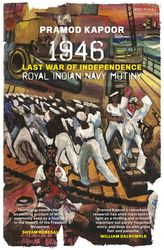IN FEBRUARY 1946, sailors of the Royal Indian Navy rose in rebellion. Enraged by terrible working conditions, discrimination and neglect, as many as 20,000 men captured 78 ships and 21 shore establishments, and replaced British flags with that of the Congress, the Muslim League and the Communist Party of India. Ordinary people took to the streets to support the mutiny.
To quell it, the British sent warships and fighter planes. The ratings responded by training naval guns on the Gateway of India, Yacht Club and dockyards.
It was, writes award-winning publisher Pramod Kapoor, India’s last war of independence—one that hastened the end of the British Raj. But the details of the mutiny have been left out of popular narratives of India’s freedom struggle. After years of research, Kapoor has come out with a book that brings to light a forgotten chapter in India’s freedom struggle. Exclusive excerpts from 1946 Royal Indian Navy Mutiny: Last War of Independence:
BOMBAY WOKE TO what became the bloodiest day of the mutiny. On Friday (February 22, 1946), even as the political leadership turned their backs on the ratings, ordinary citizens took to the barricades to bravely face tanks and bullets in support of the strikers.
Newspaper reports estimated that somewhere between 350 to 700 people were killed and between 1,000 to 1,500 people were injured, some gravely.
This day of martyrdom belonged to the workers and students of Bombay. The civilian death toll was comparable to the massacre at Jallianwala Bagh on Baisakhi Day, 13 April 1919. The difference was, in Bombay, civilians—mill-workers and students—fought pitched battles against British troops and policemen. And, in contrast to Jallianwala Bagh, 22 February 1946 is not commemorated by any memorial or ceremonies, and it has been edited out of the ‘approved’ history of the Independence Movement.
◆ ◆ ◆
THE RATINGS HAD gauged that the national leaders were not on their side. Two major political parties, the Congress and the Muslim League, had been uncaring and unequivocal in their disapproval and were both discouraging the ratings from continuing their protest. Only the communists had stood solidly behind these brave young men.
◆ ◆ ◆
FEARFUL THAT THE communists and ratings were gaining public sympathy, Sardar [Vallabhbhai] Patel stated that Congress was fully qualified to resolve their grievances.
Whether by design or accident, Patel undermined the ratings’ cause by publicly speaking out against the strike. The Congress clearly wanted a negotiated settlement with the British.
One theory is that the Congress simply did not want to share the glory of gaining freedom with these young men who had become the new poster boys for the freedom movement. Another possibility was that they wanted the British on their side, even after independence….
On the morning of 22 February, the Free Press Journal and other newspapers carried a statement by Sardar Patel: ‘There should be no attempt to call for a hartal or stoppage of mills or closing of schools and colleges. The Congress is a big party in the central assembly and it is doing its best to help them (ratings)…. Such a thing is not likely to help the unfortunate naval ratings in their efforts to get redress… All efforts are being made by the Congress to help them out of their difficulty and to see that their genuine grievances are immediately redressed. I would, therefore, earnestly appeal to them to be patient and peaceful….’
The Sardar was an elder statesman and his words carried a great deal of weight. His statement was a quintessential example of ‘neutrality in a conflict’. It did what it was intended to—it left people confused.
◆ ◆ ◆
LET DOWN BY the political leaders who claimed to be fighting for independence and threatened with overwhelming force by the British, the ratings saw their best option as a direct plea to the people.
They issued an appeal to citizens to support them by conducting a sympathy strike. People poured out into the streets in response…. Shouting patriotic slogans and plastering posters urging Indian soldiers in the British army not to fight their fellow Indians, crowds thronged the Gateway of India. By now, the authorities had replaced Indian troops with British ones, preventing ratings from coming ashore. This created more anger as people made their feelings known to the forces who tried to beat them back.
◆ ◆ ◆
THE [BRITISH] TROOPS trained their guns on the ratings, preventing them from landing. The shouting and sloganeering reached fever pitch. The troops sensed the dangerous mood of the crowd and hesitated to attempt a crackdown which could backfire badly.
While ratings on the ships could not come ashore, those in the barracks had no problems moving around. Dressed in civilian clothes, the ratings at the Fort Barracks moved out into the city early in the morning.
◆ ◆ ◆
STARTING 22 FEBRUARY, Bombay burnt for three days. There was no end to the mob fury. Battles between British troops with machine guns and stone-throwing mobs took place all over the city. Looting, arson and stone-throwing was especially severe at Sandhurst Road, Ripon Road, Northbrooke Gardens, Abdur Rehman Street and Kalbadevi, as the unrest spread all over the city….
Indiscriminate firing in all of Bombay, particularly Fort area to Dadar, led to bodies piling up. But the fights continued as defiant citizens huddled behind barricades and hurled stones. Well-armed and well-trained British forces were unable to control civilians armed with stones. Common citizens, sick of years of brutal suppression, refused to back down.
1946 Royal Indian Navy Mutiny: Last War of Independence
By Pramod Kapoor
Published by Roli Books
Price Rs695; pages 376


